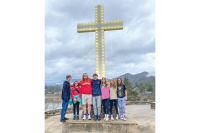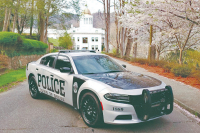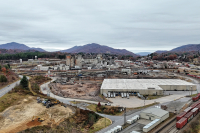The Cataloochee exodus: Story of picturesque valley’s transformation captured in new film
 Raymond Caldwell was 15 years old when he hitched up a team of horses to a wagon with 30 bushels of corn in tow, leaving the only home he and his ancestors had ever known in the idyllic Cataloochee Valley.
Raymond Caldwell was 15 years old when he hitched up a team of horses to a wagon with 30 bushels of corn in tow, leaving the only home he and his ancestors had ever known in the idyllic Cataloochee Valley.
“I drove the wagon all over the farm, but that was the first time I ever drove it out of there,” said Raymond. It was a high stakes assignment, since the load represented the fall corn harvest and needed to last the family and livestock through the winter at the new farm they were heading to across Haywood County.
The family’s milk cow was tied to the back of the wagon to boot.
“She followed us all the way out of there,” Raymond said.
“She didn’t have a choice but follow you, did she?” quipped his younger brother Harley Caldwell.
Related Items
Now 90 years old, Raymond will see his own childhood and the hardscrabble existence of his ancestors come to life in a two-hour feature documentary. Called simply “Cataloochee,” the movie traces the people, culture and history intertwined with this remote corner of the Southern Appalachian landscape, a picturesque valley cradled by the towering peaks of the Smoky Mountains.
Harley only has one regret when he reflects on the four-year project to produce the documentary “Cataloochee.”
“We should have done it 20 years ago,” Harley said. “Too many people were lost.”
“We should have done this 30 to 40 years ago,” countered his cousin Marshall Caldwell, 84.
“Isn’t that the truth,” Harley said. “We lost so many in that time.”
What began as an oral history project to document the memories of Cataloochee old-timers evolved, somewhat by happenstance, into a full-blown feature length documentary. The film traces the evolution of Cataloochee from the time of the Cherokee to the first settlers to the creation of the Great Smoky Mountains National Park, when hundreds of mountain families were forced to leave their farms and homesteads there.
But it began as a far more humble undertaking, a mission to collect interviews with every Cataloochee native who was living.
The Cataloochee Council, an offshoot of the Haywood County Historical Society, took their idea to the Mountain Heritage Center at Western Carolina University, which in turn lent them the recording equipment they needed.
It took nearly a year, but the small team of Cataloochee descendents eventually amassed dozens of hours of raw footage from 32 old-timers. Nearly all the living Cataloochee natives who were contacted were open to the project. A few couldn’t participate due to health reasons. Only two actually declined to be interviewed, mostly because they were uneasy about being on camera.
“Many felt like they didn’t have anything to say, but of course they did,” said Patrick Womack, a Cataloochee descendent involved in the project. “They were eager to contribute. They want to preserve this history. I heard these stories growing up and it is worth preserving.”
Womack, the pastor of the First Presbyterian Church in Hazelwood, was roped in to being the interviewer for the project.
“I was looking for the question they would take and run with,” said Womack.
They soon began wishing for a way to disseminate and share the vast store of recordings they’d collected.
“Initially, all we wanted to do was preserve these oral histories, what people remembered about Cataloochee so it would be kept,” Womack said. “Then we thought we needed a way to boil all this raw video down into something that would be viewable.”
Enter Katherine Bartel, a film student at WCU.
Bartel wasn’t the traditional college student. She was semi-retired from a career as an art professor at a university in Illinois. She had moved to Western North Carolina with her husband after he got a professorship in the teaching college at WCU. Bartel put her own time to use going back to school in WCU’s Film and Television Production program.
When the group of Cataloochee descendents told the Mountain Heritage Center they wished there was a way to edit and package all the footage they’d collected, they were pointed to Bartel.
“As a film student I did some work for the Mountain Heritage Center and they got to know me and got to know my work,” Bartel said.
She needed a senior film project anyway, so the timing was opportune. Ultimately, her senior thesis turned into a marathon three-year project.
“It takes a long time. It is like writing a novel. You lay down the story line once and then you go back through and rework it and rework it and cut things and move things around until you finally have a cohesive novel,” Bartel said.
The documentary was finished in the spring, but has been through a painstaking review process, including screenings with those who appear in the film to verify facts and dates and names.
“We wanted to show it to the Cataloochee natives the local historians to make sure there weren’t inaccuracies and to get feedback,” Womack said.
The Cataloochee descendents behind the original oral history project never imagined the path the project would take when they were first introduced to Bartel.
“We just wanted someone with time, expertise and equipment to edit the interviews,” Womack said. “Her vision was something grander, something that would be a UNC-TV, PBS quality documentary. She wanted to tell the bigger story.”
Bartel had to start over from scratch collecting the interviews with Cataloochee natives. She needed more professional, high-definition video and audio than the volunteers had collected with the handheld camera they’d been loaned for their oral history project.
“We weren’t thinking professional quality. We just wanted to record the stories,” Womack said.
For her part, Bartel has stumbled into a gold mine of material for a wannabe documentary producer.
“It was really rich ground,” Bartel said.
But Bartel discovered the real treasure trove, more so than the archetypal storyline, was the people. The old-timers spent untold hours with Bartell, sharing their memories, their artifacts and photos.
Being from Illinois, she encountered some expected cultural barriers.
“We had to learn to communicate with each other. Sometimes we would be talking past each other a little bit but we figured out how to work through it,” Bartel said.
But she was never shunned for being an outsider.
“They are such open, generous people,” Bartel said.
Technology gaps were the biggest hurdle for Bartel when working with the Cataloochee descendents.
Harley Caldwell, the main coordinator and liaison behind the project, is the youngest of the Cataloochee natives. He was just 11 months old when his family moved away from the valley, and is now just 76 — a whippersnapper compared to most who are well into their 80s and 90s. But even Caldwell doesn’t use a computer.
Instead, he totes a briefcase of spiral notebooks, legal pads, steno pads and paper files. A tiny pad and a handful of pens and pencils are never further than his shirt pocket.
The relationship between the Cataloochee descendents and Bartel was a symbiotic one, however.
Bartel spent untold hours visiting them in their homes, poring through their collections of family photos, scanning them and getting them properly labeled and identified. A photo slideshow is included as a special feature on the DVD of the documentary.
They could point her in the direction she needed to go, and she could make it happen.
For example, a Smithsonian oral historian famous for his early recordings of Appalachian music had passed through Cataloochee. Bartel was able to track them down and use the original audio of songs and stories collected by Joseph Hall in Cataloochee back in 1939. Harley and the other descendents then helped her match up the recordings with the right old photos.
The documentary also includes original footage of President Roosevelt’s famous dedication speech made from Newfound Gap, anointing the Great Smoky Mountains as the newest edition to the national park system in the 1930s. The Haywood County Historical Society had to pay $1,200 in licensing fees to NBC for permission to use the historic clip. But it was worth it, Harley Caldwell said.
“It made it, it really did. It had to be in there,” Harley said.
Mountain music has a starring role in the documentary. It is laced with old recordings of mountain music, but also fresh tracks laid down by three Cataloochee brothers, all born in the valley, and one of their sons. Known as the Hannah Family, the group of musicians spent a day in the recording studio at WCU.
But the documentary also has an original score, written and arranged by WCU music professor Damon Sink to fill the voids.
“We went through the entire film, minute by minute and said, ‘OK what does this part need?’ And he wrote all the bridges, underscores, and emotional notes in the movie,” Bartel said.
The real gems of the documentary, of course, are the stories about daily life in Cataloochee and the life the people carved from the land.
“We grew everything we ate,” said Raymond Caldwell, 90, who was one of eight children. “There was enough, my mother saw to that.”
Caldwell described stringing beans with a needle and thread and hanging them in the sun to dry, harvesting honey from the two dozen or so bee gums and cooking molasses from the sorghum cane.
“You talk about how we did it? Well, everybody worked,” Raymond said. “You put out an acre of Irish potatoes, that’s a lot of Irish potatoes. You put out a quarter-acre sweet potato patch, that’s a lot of sweet potatoes.”
Still, Raymond recalls the clothes having patches over the top of patches, they would get so worn out.
In the winter, Raymond’s father would make him leave for school early to start a fire in the woodstove at the two-room schoolhouse.
“I was third in my class. Think about that — an old country boy being third in his class,” Raymond said proudly of his school years in Cataloochee. “The only other two in my class were my cousins.”
As for the stories, some might sound like tall tales. Like the time Marshall Caldwell’s mother was given an herb by a Cherokee man to help treat his childhood asthma. His mother made a tea from it and Marshall drank it, as did his older brother.
Soon, they were swooning on the floor. It was night, and Marshall’s father was away working in a Civilian Conservation Corp camp. Scared the children were ill, their mother bundled them up and set off down the mountain with a lantern in hand to see kinfolk who had a car and took them into Waynesville to see the doctor.
“He said there’s not a thing in the world wrong with them except they’re drunk,” Marshall recounted.
Turns out, his mother was supposed to have him inhale the smoke from the herb, not drink it.
“They are all truth. That is one thing we made sure of,” Harley said of the stories.
Even Paul Woody’s story about the time his father tackled a calf while driving his herd down Main Street in Waynesville. It was during the great migration out of Cataloochee after the coming of the national park. Woody’s father was driving the family’s cattle across the county to a new farm in Bethel, and Main Street was the only route through town.
A calf saw its reflection in a store window, got spooked and started to charge.
“All he could think about was he was going to have to pay for that window and he reached out and grabbed the calf in a bear hug,” Woody recounts in the documentary.
Stories of leaving Cataloochee are some of the most poignant in the documentary.
Family heritage and tradition was deeply intertwined with the land itself. So giving up their farms and homesteads was like giving up part of themselves.
Harley was just 11 months old when the family moved away from Cataloochee. He doesn’t remember anything himself — only the stories he was told. And so despite the work he put into the documentary project, he doesn’t appear in the movie himself.
His cousin, Marshal Caldwell, however, was seven when they had to move out, and claims he remembers plenty.
“Have we got all evening?” Marshall replied, when asked how much he recalled from his short boyhood in Cataloochee. “For someone taken from their home place as a young child, as they grow up it becomes more fonder to them.”
Documentary showing set for Dec. 20
A free, public screening of the new feature-length documentary “Cataloochee” will be held at 7 p.m. Friday, Dec. 20, at the Haywood Community College auditorium.
The documentary chronicling the rich heritage of Cataloochee, an enclave of the Great Smoky Mountains National Park, has been more than three years in the making.
Likened to the sweeping epic on national parks by Ken Burns — the blockbuster documentary series that chronicles the trials and triumphs behind our iconic American landscapes — the powerful storyline of “Cataloochee” is just as sweeping and just as epic as what Burns tackled on the national level.
While it’s a daunting comparison for the “Cataloochee” filmmaker Katherine Bartel, she’s gotten used to the analogy whenever she tells people about the project. It’s Bartel first full-scale documentary, but she couldn’t have asked for a better gold mine.
“It was really rich ground. I really loved the universal themes in the story. The story provides a wonderful way to look at our relationship with land,” Bartell said.
The documentary begins with the time of the Cherokee, followed by the arrival of European hunters and trappers, and then white Appalachian settlers in the early 1800s.
“They have to survive. They have to feed their family. That meant growing crops and growing corn especially, and that meant clearing land in order to have fields,” said Bartell, who lives in Haywood County. “They worked very hard at that.”
But by 1920, logging companies were devouring the Smokies’ forests and closing in on Cataloochee.
“For them, land was to be exploited,” Bartel said of the timber barons.
The massive and destructive clear-cutting ultimately ignited the wilderness movement.
“For them land is to be preserved,” Bartel said.
But it came at the expense of Cataloochee’s settlers, who become collateral damage in the creation of the Great Smoky Mountains National Park.
“So there are all these wonderful themes and conflicts in the story,” Bartel said.
The documentary captures the heartache of Cataloochee residents when they were forced to leave their family farms to make way for the park. They loaded their wagons with their possessions and drove their livestock to new homes and farms across the mountains, but they could never reconstruct the life they once knew in the secluded and picturesque Cataloochee Valley, Bartel said.
“They were such a close-knit community. Losing their land to the park was a real loss of relationships that they feel to this day,” Bartel said.
The documentary doesn’t end there, however. Cataloochee descendents are still drawn back to their roots by the shared bond of both ancestry and land, witnessed by the large reunion held every year back in Cataloochee. The film drops in to their annual Sunday afternoon picnic, where a few hundred people congregate at a white clapboard church still standing in the valley, preserved by the national park as an artifact of the past but still used for weddings and gatherings by today’s descendents.
The national park, in the end, actually helped preserve Cataloochee’s heritage — or at least the memory of it — which has been frozen in time thanks to the uncorrupted landscape.
“The second generation has had the benefit of hindsight. Several people in the movie talk about the park being a good thing in the long run. Most of them have come to that conclusion,” Bartel said.
The documentary began as an oral history project by Cataloochee descendents with the Haywood County Historical and Genealogical Society, but it evolved into a two-hour, professional-quality film thanks to a partnership with Western Carolina University.
The rights to the documentary belong to the Haywood County Historical Society. They plan to sell copies of the DVD for $25. A slideshow of historical family photos from Cataloochee is included in the DVD as a special feature.
After paying back the upfront costs incurred in the production, the proceeds from DVD sales will be spent preserving the history of Cataloochee, such as a restoration of historic buildings or improved interpretive displays in the park.
“Hopefully we can put every penny back into Catalooch,” said Harley Caldwell, a Cataloochee descendent who spearheaded the project.









